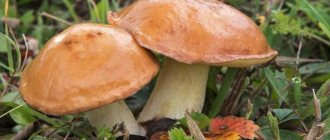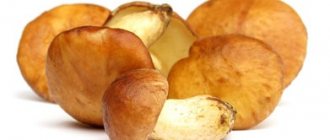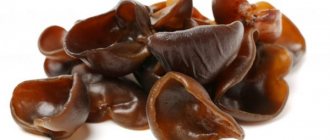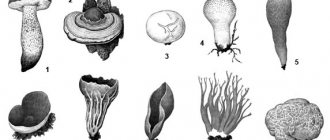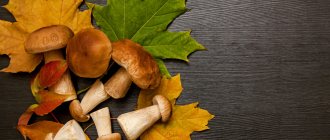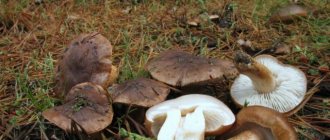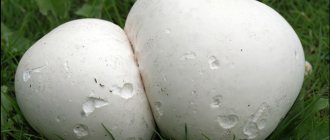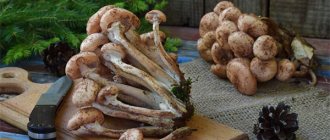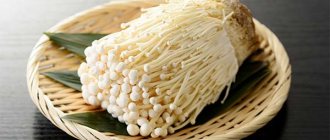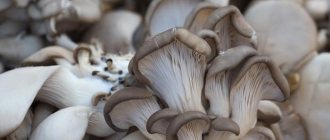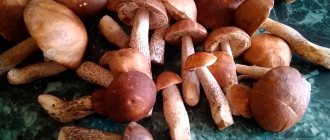5
(2)
Mushrooms are used in cooking and as raw materials for making medicines. Dishes and products based on them strengthen the immune system and bones, improve the functioning of the brain and cardiovascular system, and prevent the development of tumors. Information about what vitamins are in mushrooms will help you decide whether to include the product in your diet on an ongoing basis.
- Oyster mushrooms
- For women
- Dried
- Symptoms
The benefits of mushrooms lie in their unique balanced composition.
General chemical composition of mushrooms
100 g of mushrooms contain:
- proteins - 1.6-3.7 g;
- fats - 0.9-1.7 g;
- carbohydrates - 1.1-7.6 g;
- organic acids: citric, tartaric, oxalic, fumaric;
- enzymes: amylase, lipase, cytase, urease.
Vitamins
The amount of vitamins in mushrooms (per 100 g) depends on their type:
- A - 0.002-0.005 mg;
- ascorbic acid (C) - 7-34 mg;
- tocopherol (E) - 0.1-0.9 mg;
- thiamine (B1) - 0.003-0.14 mg;
- riboflavin (B2) - 0.3-0.85 mg;
- niacin (PP, B3) - 4.8-8.5 mg;
- pantothenic acid (B5) - 2.1-2.7 mg;
- pyridoxine (B6) - 0.007-0.3 mg;
- folic acid (B9) - 0.003-0.004 mg.
The composition of mushrooms includes a large number of different vitamins and microelements.
Microelements
In addition to vitamins, mushrooms contain the following microelements (per 100 g of product):
- potassium - 450-468 mg;
- phosphorus - 44-89 mg;
- magnesium - 7-15 mg;
- iron - 0.5-1.3 mg;
- calcium - 4-13 mg;
- zinc - 0.25-0.33 mg;
- chlorine - 22-24 mg.
The nutritional value
Different types of mushrooms differ in the content of proteins, fats and carbohydrates (BJU) (see table).
| Name | Proteins, g | Fats, g | Carbohydrates, g |
| White | 3,7 | 1,7 | 1,1 |
| Oyster mushrooms | 3,3 | 0,4 | 3,8 |
| Milk mushrooms | 1,8 | 0,8 | 0,5 |
| Chanterelles | 1,5 | 1,1 | 1 |
| Butter | 2,4 | 0,7 | 0,5 |
| Honey mushrooms | 2,2 | 1,2 | 0,5 |
| boletus | 2,3 | 0,9 | 1,2 |
| Boletus | 3,3 | 0,5 | 1,2 |
| Saffron milk caps | 1,9 | 0,8 | 0,5 |
| Russula | 1,7 | 0,7 | 1,5 |
| Champignon | 4,3 | 1,0 | 0,1 |
| Shiitake | 2,2 | 0,5 | 4,3 |
Calorie content
Porcini and shiitake mushrooms are considered the most nutritious (34 kcal each).
Porcini mushrooms are the most nutritious.
Energy value of other species (in kcal):
- oyster mushrooms - 33;
- chanterelles - 32;
- honey mushrooms - 22;
- boletus - 22;
- saffron milk caps - 22;
- champignons - 22;
- boletus - 20;
- Russula - 19;
- milk mushrooms - 16;
- boletus - 9.
Fried potatoes with porcini mushrooms
Photo: Restaurant "Shinok"
Recipe by Elena Nikiforova, chef of the restaurant "Shinok"
- 1 kg potatoes
- 200 g fresh porcini mushrooms
- 200 g onion
- 200 ml vegetable oil
Article on the topic
The main Russian mushroom. Recipes for salads and white risotto
Step 1. Wash, peel and cut the potatoes into round slices.
Step 2. Fry porcini mushrooms in a separate pan.
Step 3. Separately fry the onions.
Step 4. Place the potatoes in a heated frying pan with vegetable oil. As soon as the potatoes are ready, add the fried mushrooms and onions.
Step 5. Stir and continue frying so that the potatoes acquire a mushroom aroma. Add salt.
Step 6. Place potatoes with mushrooms on a plate and sprinkle with chopped dill.
Benefits of different types of mushrooms
Most mushrooms have medicinal properties and benefit the body.
Oyster mushrooms
These mushrooms contain large quantities of polysaccharides, valuable proteins and amino acids, minerals and vitamins - B, E and especially D2, due to which they have a pronounced antitumor effect.
Oyster mushrooms have the ability to bind and quickly remove toxins and radionuclides from the body, so they are recommended for use by patients for recovery after chemotherapy and radiation treatment.
If you enter this product into the menu, you can:
- reduce sugar levels in diabetes;
- strengthen the immune system;
- destroy the Coxsackie B5 virus;
- reduce cholesterol levels;
- improve the functioning of the cardiovascular system;
- cure dysentery;
- normalize bile secretion and diuresis;
- improve potency;
- prolong the period of remission for bronchial asthma;
- cure emphysema.
Oyster mushrooms reduce sugar levels and strengthen the immune system.
Champignon
These mushrooms are the lowest in calories, so nutritionists recommend including them in your diet when losing weight.
Champignon-based products:
- support the immune system;
- strengthen vascular walls;
- stimulate intestinal activity;
- remove toxins;
- reduce blood glucose levels;
- stimulate brain function;
- reduce the risk of stress, depression, neuroses;
- relieve headaches;
- improve memory and concentration;
- increase visual acuity;
- strengthen bones and teeth;
- improve the condition of hair, nails, skin;
- regulate the metabolism of saturated fats and sugars;
- reduce cholesterol levels.
It is recommended to eat champignons when losing weight.
The juice of fresh fruiting bodies has disinfecting and antimycotic properties.
Honey mushrooms
Honey mushrooms are used for food and treatment:
- hypertension;
- gastrointestinal diseases;
- weakened visual acuity;
- respiratory diseases of various etiologies;
- consequences of ionizing radiation.
In folk medicine, a decoction of honey mushrooms is used to restore the body after a long illness or surgery.
It stimulates microcirculation in brain tissue, improves cognitive functions, and improves mood. The water infusion has pronounced analgesic properties. An ointment is prepared from honey mushrooms to treat joint diseases.
Honey mushrooms are used to treat hypertension and gastrointestinal diseases.
Chanterelles
These mushrooms are used in therapy:
- liver diseases, including hepatitis;
- obesity;
- eye diseases;
- cerebrovascular accidents;
- helminthiases;
- tonsillitis;
- furunculosis;
- diseases of the nervous system.
Chanterelles are used for obesity and liver diseases.
Chanterelle products stimulate digestion and improve visual acuity.
White
Boletuses have an active antitumor effect due to general stimulation of the immune system and triggering the synthesis of interleukins - specific compounds of the immune system that destroy tumor tissue. Helps restore the body after radiation and chemotherapy, severe surgery, infection, trauma.
In medicine, porcini mushroom extract is also used for:
- frostbite;
- thermal and chemical burns;
- immunodeficiency states.
How to properly collect wild mushrooms
There are several rules for collecting forest mushrooms, the observance of which will allow you to avoid mushroom poisoning:
1. It is necessary to collect mushrooms as far as possible from cities, highways, railways and factories outside the city, especially those with hazardous production. Mushrooms are like a sponge; they absorb both good and bad properties. Heavy metals, which are “stuffed” with mushrooms growing near roads, can cause poisoning. The best places for picking mushrooms are ecologically clean areas far from the city.
2. Collect only those mushrooms that you know. If you have doubts about the edibility of a particular mushroom, it is better not to take it. Even if you really want to collect a lot of mushrooms. Health is more valuable.
3. Try to collect mushrooms in wicker baskets. This way they will retain both their freshness and their appearance longer. It is not advisable to collect mushrooms in plastic bags. The mushrooms in them quickly wrinkle, crumble and become unusable.
4. Try to cut mushrooms with the stem intact. So, when processing a mushroom at home, you can easily determine what kind of mushroom it is.
5. Do not collect wormy mushrooms. There is practically no chance of removing worms from a mushroom, even if soaked in salt water. And then eating such mushrooms is not only not advisable, but also not very pleasant. In addition, worms from one mushroom may well crawl into another while you get home.
6. Do not collect overgrown, old or damaged mushrooms. There are not many chances to bring them home, and instead of neat mushrooms, you will bring home a “mash” that you will throw away during processing.
7. Do not collect poisonous mushrooms or inedible mushrooms. No methods or recipes for neutralizing poisonous mushrooms will work. Simply because poisonous mushrooms cannot be neutralized!
8. It is best to pick mushrooms in the morning, before the sun warms them. Mushrooms picked when it's cold last longer.
In order for mushroom dishes to bring us not only benefits, but also pleasure from eating them, mushrooms must be properly collected, carefully processed and properly prepared. As a rule, mushroom dishes are very tasty and easy to prepare.
Be careful, and then any mushroom dish will only benefit our health.
Useful properties of mushrooms
This product is beneficial for both men and women. It is used in dietary nutrition and treatment of many diseases.
For women
Mushroom-based products are used to rejuvenate and moisturize the skin, in the fight against ulcers and acne. Chitin, calcium, phosphorus, sodium in the composition of fruiting bodies have a beneficial effect on the growth, structure, strength of hair and nails.
Some types of edible mushrooms are used for:
- PMS;
- “hot flashes” during menopause;
- hormonal imbalance;
- bleeding, including uterine bleeding;
- painful menstruation;
- osteoporosis;
- dermatosis;
- furunculosis;
- diseases of the genitourinary system;
- breast and ovarian cancer.
Mushrooms are used for hormonal imbalances and PMS.
For women who want to lose weight, nutritionists advise introducing 120-150 g of mushrooms into their diet.
If there are no contraindications, dishes made from them can be eaten daily.
For men
Nutritionists recommend that men eat mushrooms to control weight. For athletes - for quick recovery, relief of soreness, increased performance, preservation of muscle tone and relief during “drying”.
Mushroom extracts and extracts are used to treat:
- baldness (alopecia);
- diabetes;
- alcoholism;
- hypertension;
- sexual dysfunctions;
- coronary heart disease;
- arrhythmias;
- atherosclerosis.
Mushroom extracts are used for baldness.
During pregnancy
Experts do not recommend pregnant women to eat mushrooms. They are considered heavy food; they are poorly digested and take a long time to digest, so they can cause dyspeptic disorders. The product is especially contraindicated for existing diseases of the gastrointestinal tract, complicated pregnancy.
At what age should it be given to children?
You can start giving mushrooms to children no earlier than 6-7 years old and only in small quantities.
Children are given mushrooms no earlier than 6-7 years old.
Boost immune function
Due to polysaccharides, beta-glucans, vitamins and minerals, most edible mushrooms have immunomodulatory and immunostimulating properties.
Fighting cancer
They influence the development of tumors through stimulation of cellular and humoral immunity. They contain anthocyanins, which have a preventive effect and suppress oncogenes. Contain lecithin, which inhibits the growth of tumor tissue.
Fungi suppress oncogenes and inhibit the growth of tumor tissue.
Reduce the risk of developing diabetes
Antidiabetic effects of mushrooms:
- increased glycogen synthesis in the body;
- increased glucokinase activity;
- inhibition of glycogen synthase kinase;
- activation of glucose use by peripheral tissues.
In addition, they reduce the risk of developing complications of diabetes: mycosis of the feet, candidiasis, neuropathy, retinopathy, nephropathy, liver pathologies, and diseases of the cardiovascular system.
Supports heart and vascular health
Due to the minerals they contain, mushrooms help strengthen the walls of blood vessels, maintain the tone of the heart muscle, normalize cholesterol levels and prevent the development of atherosclerotic plaques. Reduces blood pressure due to its moderate diuretic effect.
Mushrooms help strengthen the walls of blood vessels.
Promotes better brain function
Due to B vitamins, phosphorus and magnesium, mushrooms effectively influence cognitive functions and the functioning of peripheral nerves. They fight migraines and diseases that destroy the cerebral cortex: Alzheimer's disease, multiple sclerosis.
Promote weight loss
Due to their low calorie content and the presence of lecithin, which promotes the rapid appearance and long-term maintenance of a feeling of satiety, mushrooms are included in dietary dishes. You can use them during fasting days.
Mushrooms keep you feeling full and promote weight loss.
Strengthen bones
Regular consumption of mushrooms increases bone strength. The effect is due to the phosphorus, calcium and proteins contained in the product.
What is more useful - hats or legs?
Most of the nutrients, including vitamins and microelements, are found in the cap. Anthocyanins, flavonoids and aromatic oils were also found there. The leg contains large amounts of chitin and proteins, which are poorly absorbed by the body.
Nutrients are found in the mushroom cap.
Cultivated or forested - which is better?
Cultivated mushrooms are grown in enriched organic media. During industrial cultivation, the risk of deposition of harmful substances, metal salts, radionuclides from the soil, groundwater and air is eliminated. Therefore, such mushrooms are safer and healthier than forest mushrooms, especially those grown in environmentally unfavorable conditions.
Can pregnant and nursing mothers eat mushrooms?
It is permissible to consume mushrooms during early pregnancy. Be sure to choose a high-quality product, which is thoroughly boiled before use. Preference is given to the safest types: champignons and oyster mushrooms.
Advice! During pregnancy, it is better to eat stewed or boiled mushrooms. Salted, fried and pickled foods should be avoided.
It is not recommended to consume mushrooms while breastfeeding due to their high toxicity. They may contain heavy metals and other harmful substances. The spores also enter the lungs and cause allergies. As a result, the product can cause serious harm to the baby, causing colic and other digestive disorders. It is introduced into the mother’s diet no earlier than 4-6 months of lactation.
Recommended reading: Benefits of boiled beets for the body
In what form are mushrooms healthier?
Mushrooms can be dried, frozen, salted and pickled. Although during processing some of the beneficial substances may be lost.
Dried
When dried, mushrooms retain the maximum amount of useful substances, but intracellular water is completely lost. To prepare dishes, dried preparations are soaked, and their composition is completely restored. In addition, it is believed that when fruiting bodies are dried, some bonds in protein molecules are destroyed, due to which they are better digested and absorbed by the body.
Dried mushrooms retain beneficial substances.
Pickled
For this preparation method, vinegar, sugar and spices are used, which inactivate some of the nutrients.
The use of marinades should be limited due to the negative effects on the digestive tract.
Bruschetta with chanterelles
Photo: Dilly Restaurant
Recipe by Denis Krylov, chef of the Dilly restaurant
- 30 g baguette
- 60 g hummus
- 60 g vegetable caviar
- 60 g chanterelles
- 10 g pine nuts
- 5 g watercress
Article on the topic
With potatoes, apricots and shrimp. 10 fantastic chanterelle dishes For vegetable caviar (60 g per 1 serving):
- 200 g eggplant
- 150 g onions
- 150 g carrots
- 200 g tomatoes
- 3 g thyme
- 5 g garlic
- 100 g vegetable oil
- Salt and black pepper
- 100 ml chicken broth
Step 1. Prepare vegetable caviar, for this, cut the vegetables and fry with thyme and spices.
Step 2. Fry the chanterelles in a frying pan.
Step 3. Fry the baguette on both sides, spread with hummus, and top with vegetable caviar and fried chanterelles.
Step 4. Add a handful of pine nuts and garnish with watercress.
Medicinal use
Pharmaceutical preparations and dietary supplements have been created based on extracts or dried mushroom powder:
- Befungin;
- Gastrofungin;
- Chagovit;
- Chagalux;
- Reishi;
- Sanaviron;
- Mikoton;
- Mylife;
- Mipro-Vit.
Befungin is a thick extract obtained from the birch chaga mushroom.
Fly agaric tincture is used in the treatment of cancer, and externally as an analgesic and anti-inflammatory agent for joint pathologies.
Infusion and decoction of boletus caps are effective for migraines and in the treatment of gout. Chanterelle decoction is an effective anthelmintic. Tincture of honey mushrooms is used to cleanse and heal purulent wounds.
Possible harm and contraindications for use
This product is poorly absorbed by the body and puts a lot of stress on the digestive organs. Harm can be caused by heavy metals, radioactive elements, pesticides, mercury and lead compounds contained in fruiting bodies (when mushrooms grow on contaminated soil or near roads and industrial enterprises).
Poisoning by mushrooms or due to improper processing of raw materials is possible.
The product is contraindicated for use:
- for peptic ulcers of the stomach and intestines;
- for gallstone and kidney stone diseases;
- for chronic liver and kidney failure;
- children under 6 years old;
- in the third trimester of pregnancy;
- To old people;
- when exhausted.
Mushrooms are contraindicated for stomach ulcers.
Possible harm to the body
For mushrooms to be beneficial, they must be eaten boiled. After frying, they lose most of their beneficial properties. Also, these tasty plants do not go well with raw vegetables. Such combinations cause flatulence. Therefore, it is better to prepare a side dish from boiled or stewed vegetables.
There are also several other disadvantages to these tasty and nutritious plants:
- Heavy product. The body needs a lot of enzymes to digest mushrooms. Therefore, they should not be given to young children and elderly people. They may experience stomach pain and other digestive problems.
- Prolonged digestion. Since mushroom dishes are heavy food, they are not the best food for dinner. It's better to leave the plants for lunch.
- Potential allergen. Nowadays, many people suffer from food allergies. If you are susceptible to this disease, avoid mushrooms. They are one of the most dangerous allergens.
- Possibility of bloating and flatulence. Prolonged digestion sometimes leads to the fact that mushrooms begin to ferment in the intestines. As a result, gases are formed.
Mushroom poisoning
Poisoning with this product is accompanied by general symptoms characteristic of intoxication with chemical or biological poisons. The severity of symptoms depends on the strength and amount of toxin entering the circulatory system.
Symptoms
In case of intoxication the following are observed:
- cramping cutting pain in the abdomen;
- dyspepsia (in case of poisoning with toadstool, there are signs of blood in the stool and vomit);
- decreased heart rate;
- decreased heart rate;
- drop in blood pressure;
- increased body temperature;
- cold extremities;
- confusion;
- hallucinations;
- convulsions, cyanosis (caused by toadstool);
- hypersalivation, constriction of pupils, aggressive behavior (fly agaric).
When poisoning with mushrooms, a cutting pain in the abdomen is observed.
The first symptoms may appear after 1-2 or 8-12 hours, depending on the type of mushroom.
First aid
To help a person with signs of poisoning, you need to give him a large amount of water with potassium permanganate or a strong saline solution, and then induce vomiting. These steps must be repeated 2-3 times (until there is clear water in the vomit). Patients with impaired consciousness are prohibited from performing this procedure.
You should definitely seek medical help even if your condition improves.
In addition to gastric lavage, you can give from 5 to 10 tablets of activated carbon or 4-5 tbsp. l. Polyphepan or other sorbent.
How and for how long you can store mushrooms at home
Fresh mushrooms are least likely to be stored at home. Some specimens begin to deteriorate after a few hours. They are kept in the refrigerator for no more than 3 days. Therefore, immediately after collection or purchase, they begin processing before they lose their beneficial properties.
After treatment, the shelf life of the product increases significantly:
- after drying – up to 1 year;
- after marinating in jars with metal lids – 1 year;
- canned products – up to 5 years.
Rules for selection and storage
You need to choose the right mushrooms:
- purchase only in stores or official markets;
- avoid old, overgrown specimens with severe damage;
- carefully inspect the product in its original packaging, check the quality, tightness of the container, and the date of manufacture.
The presence of foreign odors (ammonia, drugs, chlorine, mold) indicates a violation of the technology for growing and storing the product. Such mushrooms are dangerous and should not be purchased.
Fresh fruiting bodies are stored in the refrigerator, but they are first washed, soaked in salt water and dried on a paper towel. Then they are transferred to a container and covered with paper or natural fabric on top. Store at a temperature of +2...+4°C for no more than 4 days.
Dry preparations quickly absorb odors and moisture, so they are kept in a hermetically sealed container without access to air or sunlight.
Edible and conditionally edible - what's the difference?
Edible mushrooms include those whose fruiting bodies (cap and stem) do not contain bitterness, harmful substances or an unpleasant odor. They can be boiled, fried and eaten immediately after harvesting, cleaning and washing, without pre-processing.
Conventionally edible mushrooms are those that contain bitter or harmful substances, have an unpleasant odor, etc. They can be eaten only after prolonged soaking, boiling and removal of the decoction, after salting and fermentation.
The two most famous conditionally edible mushrooms
White and black milk mushrooms. Used primarily for pickling.
